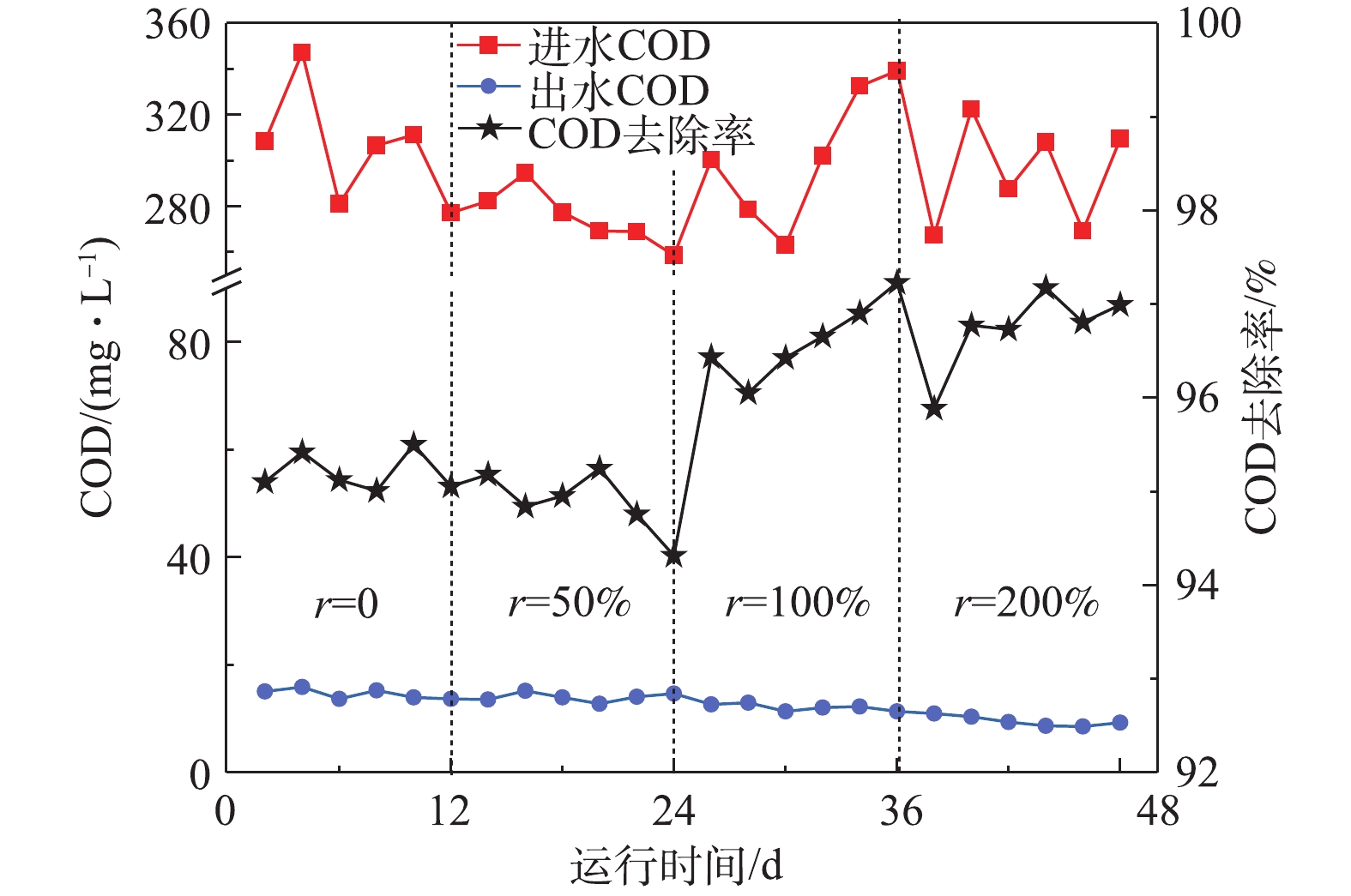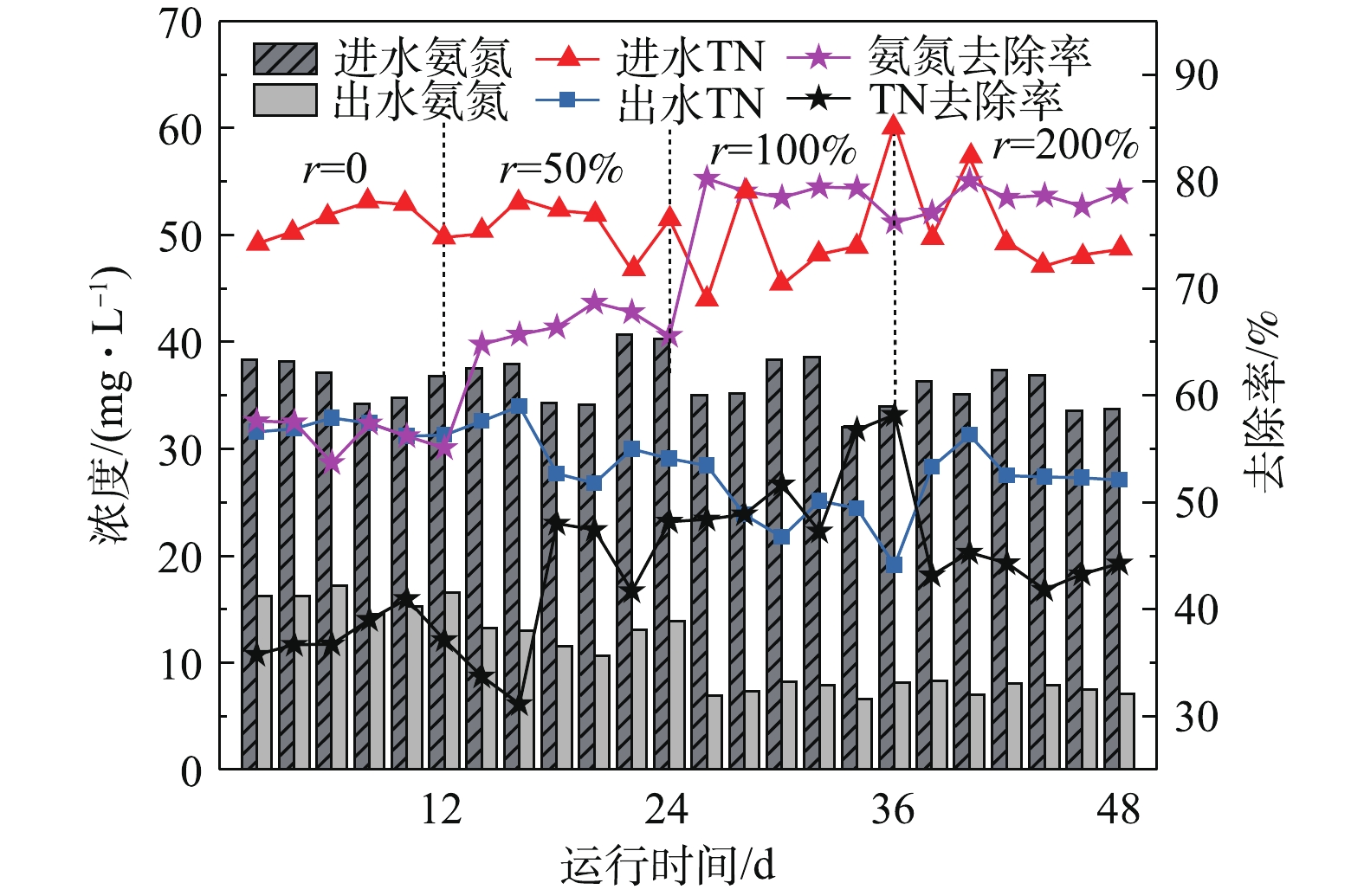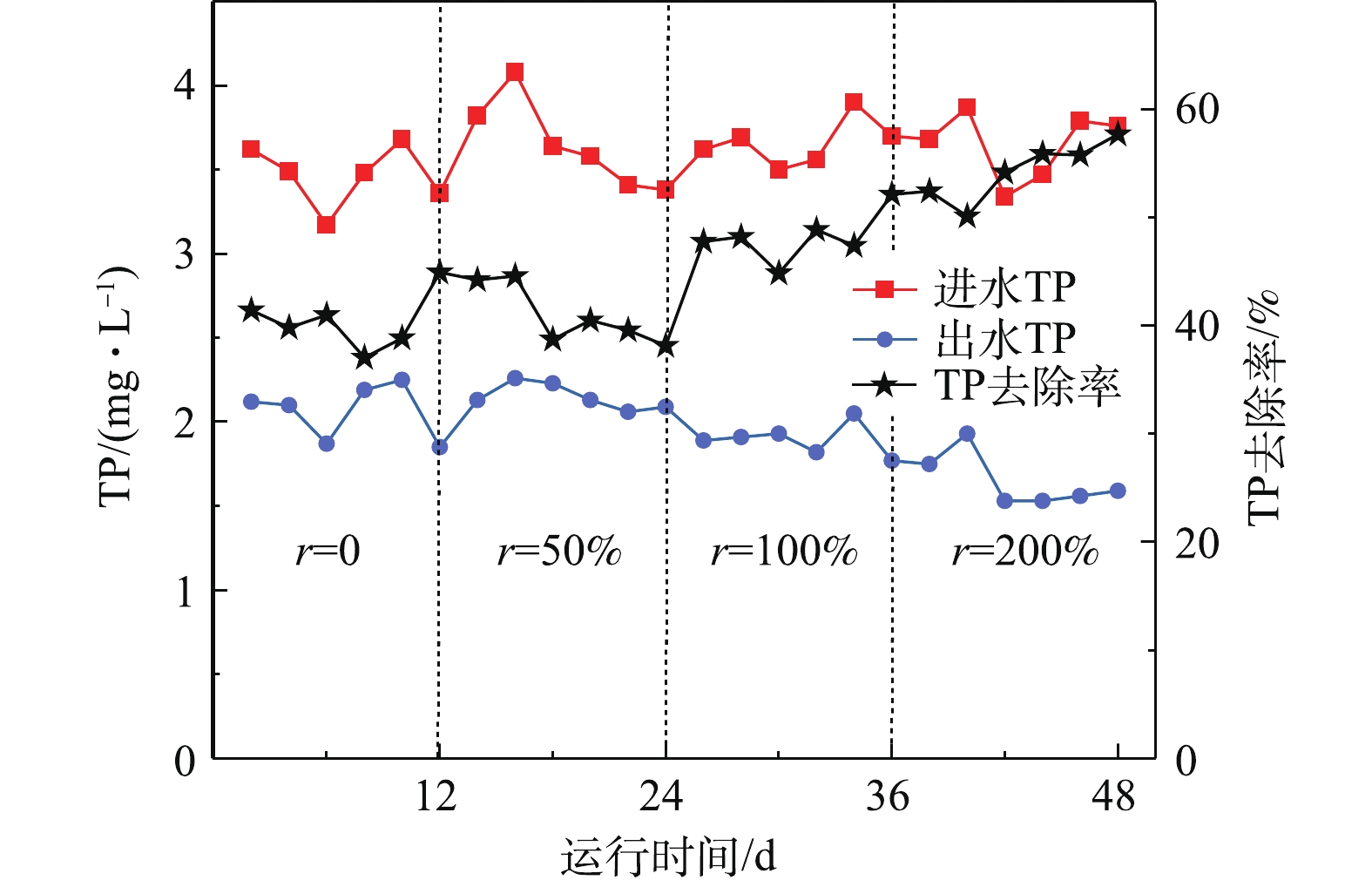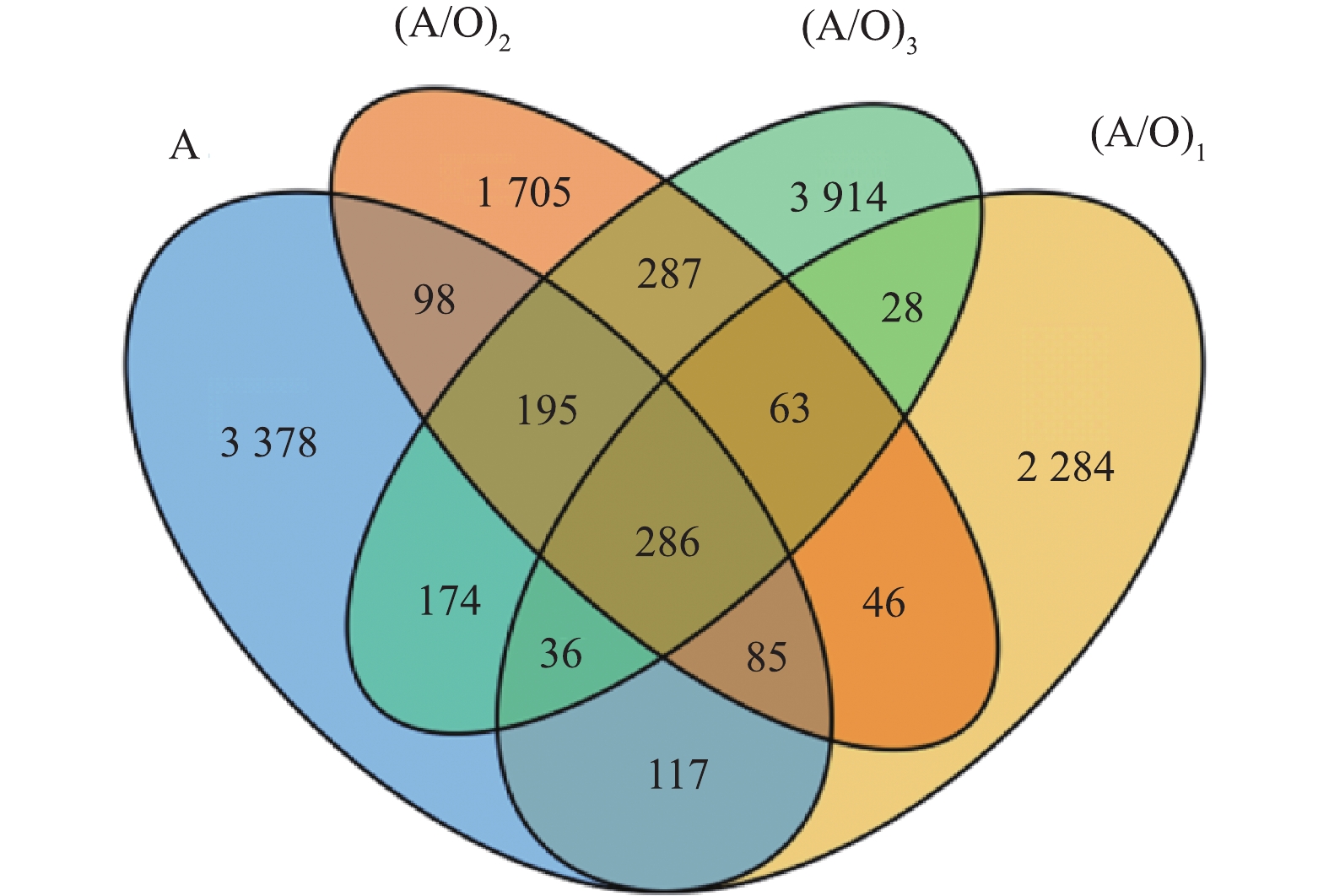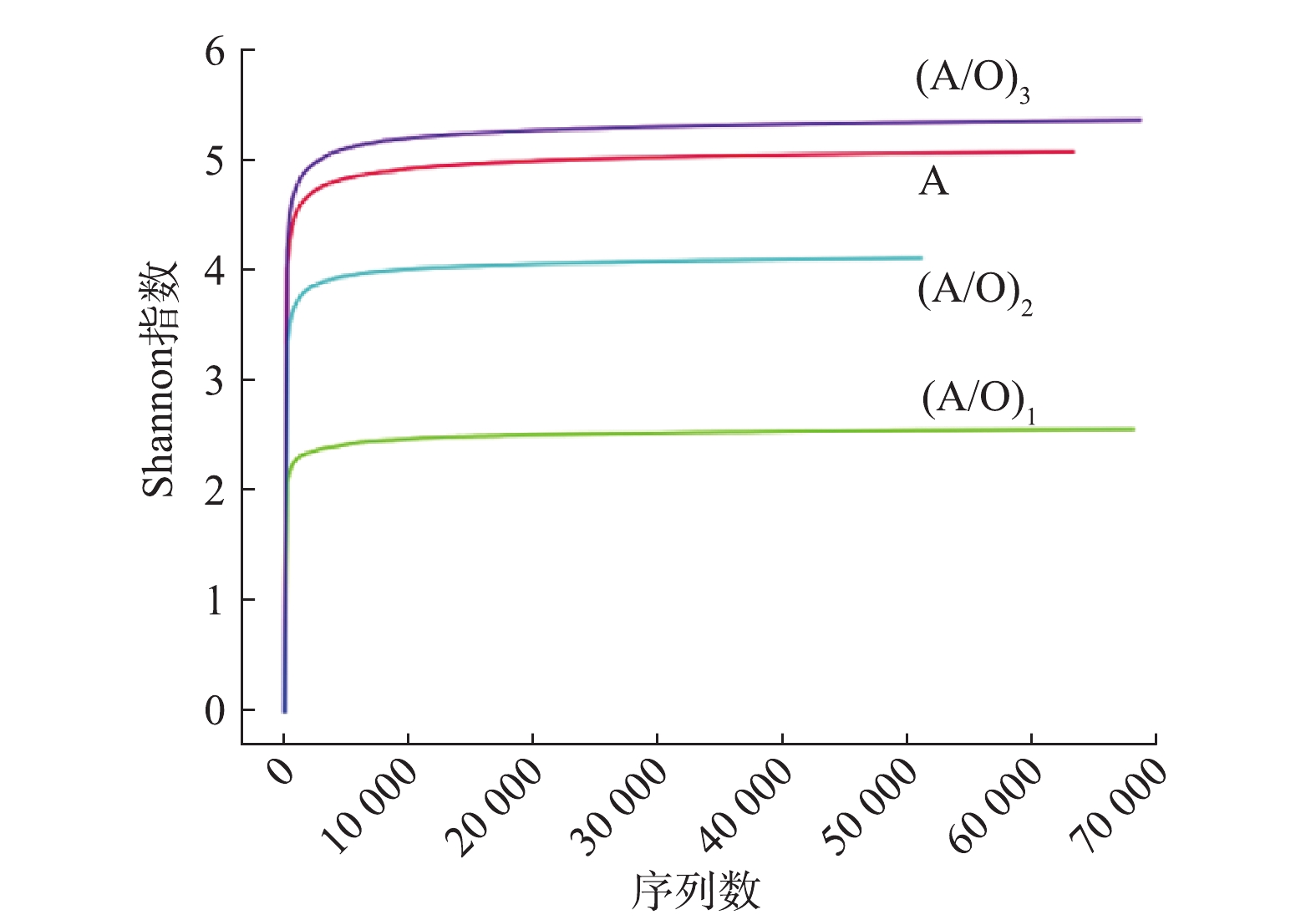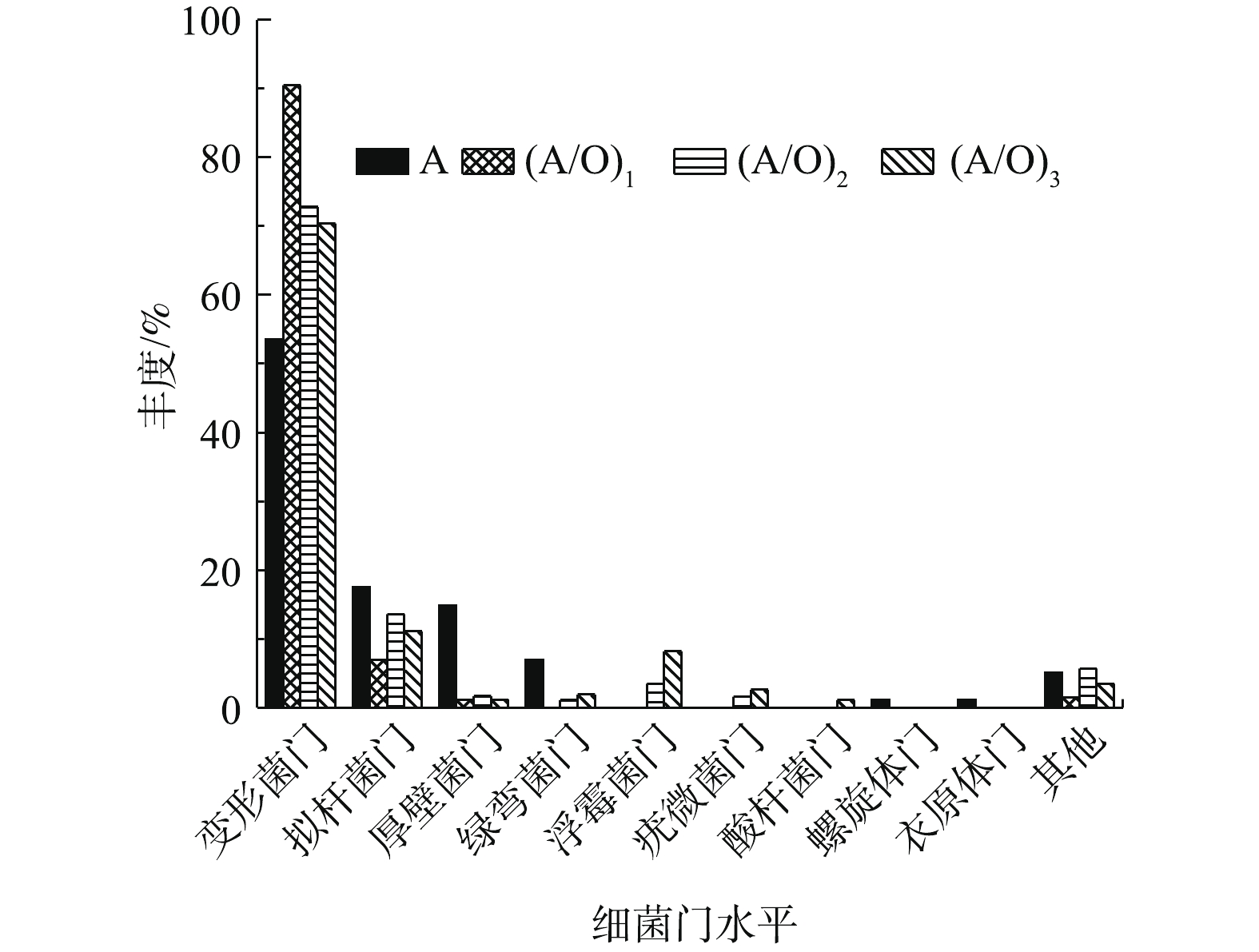-
农村生活污水作为面源污染的主要来源,具有氮磷营养素较高、分散、面广、量少、不易收集、管理水平低等特点[1-2],是导致河流、湖泊富营养化的重要原因[3-4]。因此,为提高农村生活污水处理率、研究开发投资成本低、工艺设备操作简单、低能高效、运行维护方便且适用于农村污水处理设备具有重要意义。
近年来,生物膜法凭借剩余污泥量少、抗冲击负荷能力强、运行管理方便等特点,已在水处理中被大量运用[5-6],生物滤池利用生物膜的过滤、絮凝及生物氧化作用,能够有效地去除水中引起水体富营养化的氮磷元素[7]。多级生物滤池通过设置两级及以上独立的缺氧、好氧段来进行污水处理,具有抗冲击负荷能力强、充分利用原水碳源、较好地有机物降解和脱氮等能力[8-9]。填料作为生物滤池重要的组成部分,其结构、空隙率和亲水性等属性对生物膜的生长、结构和更新均具有显著影响[10-12]。相比于其他填料,聚氨酯填料(海绵)具有寿命长、损耗低(年损耗5%)、不易堵塞、氧利用率高等优点,其独特的多孔结构可使微生物在流动状态下自动聚集于载体内部,形成三维固定化生物膜,避免了流体剪切力对微生物冲刷剥离的影响,在其外表面实现亚硝化反应,在内部实现亚硝酸盐的反硝化,不仅有简单的物理吸附,还有正、负电荷的引力。此外,聚氨酯海绵填料市售价格为860~1 200元·m−3,价格低廉,故其在水处理中受到了重视,但也存在着生物亲和性不足等缺点[13-19]。为此,本研究将改性后的海绵作为填料,构建了4级斜板生物填料滤池,并对该处理系统的硝化液回流比参数进行了考察,采用高通量测序技术分析处理池中生物膜微生物生长分布情况,为该污水处理系统的达标稳定运行提供理论依据。本研究可为实际工程中工艺结构及参数的选取提供参考,有着重要的现实意义。
全文HTML
-
1)填料。本研究使用的聚氨酯发泡海绵材料购买于江苏常州市某公司,堆积比重为26 kg·m−3,孔隙率为96.20%,整张填料的尺寸为1.00 m×2.00 m×0.02 m,将填料裁剪为0.37 m×0.15 m×0.02 m大小的尺寸,采用化学氧化-壳聚糖接枝[20-21]改性方法获得的改性聚氨酯填料以备用。
2)实验用水。根据现场调研及相关资料查阅,按照浙江省农村地区生活污水水质特征,本研究采用稀释加药法配制了实验用进水,即取一定体积的原水(北京科技大学校区内的生活污水)稀释,稀释后降低的浓度差采用乙酸钠、葡萄糖、氯化铵和磷酸氢二钾进行添加,使进水中的COD、氨氮、TP和SS浓度达到模拟农村生活污水的设计浓度值,设计浓度值见表1。出水水质需要达到浙江省《农村生活污水处理设施水污染物排放标准》(DB 33/973-2015)一级标准,其中pH的标准限值为6~9,其他主要监测指标及浓度见表1。
-
本研究实验装置如图1和图2所示。在笔者前期工作的基础上,确定了该系统由4个斜板生物滤池串联构成,运行时,第1个池体不进行曝气,后3个池体进行曝气,将其分别记为A、(A/O)1、(A/O)2、(A/O)3。
1)单池结构。单个斜板生物滤池的尺寸为0.30 m×0.15 m×0.25 m,有效容积为10.10 L,主要由进出水管、斜板式生物填料、不锈钢支撑网、曝气系统、反冲洗系统、回流液系统等构成。为防止因水流冲击造成填料的变形和移动,生物膜填料平铺在不锈钢支撑网上并以36°角进行固定,同时采用弹性压条将斜板填料与四周池壁缝隙处进行压实,防止在进水过程中造成壁流效应。斜板填料固定好后的尺寸为0.37 m×0.15 m×0.02 m,填充率约为11%,其将水池分割为上下2个相对独立的部分,可在一个处理池中同时创造好氧和缺氧的条件,这样每个A/O池均可视为一个局部的A/O系统,使同步硝化反硝化成为可能,这也是该处理系统的优势之一。
2)运行参数。实验系统采用前段单点进水,单个滤池水力负荷为1.40 m3·(m2·d)−1,进水流量约为(24±1) L·d−1,废水在每一级池体内的水力停留时间约为10 h,系统总体停留时间约为40 h。A/O池斜板填料下方好氧区溶解氧浓度控制在(2.0±0.2) mg·L−1,控制斜板上方缺氧区溶解氧浓度≤0.50 mg·L−1,第一个A池不曝气。为达到脱氮的目标,本研究将A/O池处理后的混合液通过回流泵回流至A池,利用A池中的反硝化菌将回流混合液中亚硝态氮和硝态氮转化成氮气[22],将硝化液回流比分别设为0、50%、100%、200%。
3)填料反冲洗。该污水处理系统进水开始运行初期主要依靠填料的机械截留和过滤作用来去除污水中的悬浮物质,随着水处理的进行,斜板填料截留的悬浮物质增多,逐渐形成一个生物膜,起到截留、吸收、降解有机物及氮、磷等污染物的作用[23]。随着系统运行,生物膜增厚,填料膜两侧压头损失逐渐增大。在实验阶段每12 d对填料进行1次水反冲洗,反冲洗时填料上老化的生物膜随着冲洗水而脱落并随反冲洗水排出系统,达到净化滤层的目的,同时减少了滤料两侧压差。
-
为了研究4级填料生物滤池污水处理系统的细菌群落,利于系统的操作和优化,将最优条件下的斜板生物膜样品在干冰冷冻条件下送至生工生物工程(上海)股份有限公司,采用基于16S rRNA基因V3~V4区高通量测序[24-25]分析生物膜中细菌的种类及多样性,在97%的分类水平上,通过应用Mothur软件计算各样品的Alpha多样性[26],用RDP Classifier方法与Green Gene数据库进行物种注释分析[27]。
1.1. 实验材料
1.2. 污水处理装置系统
1.3. 微生物群落分析
-
对于污水处理系统,在不同回流比条件下分别进行了12 d的运行实验,每2 d检测1次进出水COD、氨氮、TN、TP水质。本实验装置系统对于SS的去除主要来自于4个池体内斜板填料的机械截留过滤作用,在初期摸索实验阶段得知,当实验进水SS浓度为60~100 mg·L−1时,出水中SS浓度均在10 mg·L−1以下,随着运行时间的延长,出水SS浓度会进一步降低到5 mg·L−1,满足DB 33/973-2015一级标准对SS的要求,由于该指标基本不受回流比的影响,在本文中不做详细分析。
-
由图3可知,回流比从0逐渐增大到200%时,COD去除率逐渐升高并趋于平稳,平均出水COD由14.62 mg·L−1降低到9.57 mg·L−1,达到DB 33/973-2015一级排放标准,由此可见,改系统对有机物的去除率整体较高。这是由于A/O池作为污水处理系统的重要组成,在聚氨酯填料表面及内部生长的大量异养微生物的降解和吸收作用下,有机物被大量去除[28]。同时可以看到,回流比的增大促进了有机污染物的降解,这是由于回流比的增加使水力剪切作用加大,加快了生物膜的脱落和更新,提高了传质效果,同时反硝化细菌利用回流液中的硝酸盐作为电子受体,以有机污染物作为碳源来进行反硝化作用,促进了COD的去除。剩余的COD没有被微生物利用,其原因可能是难降解的有机物以及微生物通过内源呼吸的产物是微生物较难利用的碳源。
-
处理系统在不同回流比下对氨氮和TN的去除效果和去除率如图4所示。由图4可知,当回流比由0提高到100%时,氨氮的平均去除率由56.25%提高到78.83%;而当回流比继续增加到200%时,系统对氨氮去除率并没有持续增大,平均去除率为78.50%。污染物去除率的逐步升高是由于回流硝化液稀释了进水中的有机物浓度,使得A/O池内异养菌竞争力下降,硝化自养菌成为优势菌,这有利于硝化反应的进行,进而提高了氨氮的去除率。而当硝化液回流比超过100%时,回流液携带大量的溶解氧进入A池,破坏了缺氧环境,使得反硝化菌活性降低,对有机污染物的消耗降低,A/O段的有机负荷增大,自养硝化细菌与异养菌的竞争力减弱,降低氨氮去除率[29]。此外,回流比的增大导致系统的水力负荷增大,进水流速和水力剪切作用增大,使得一部分硝化菌脱落随出水流失。在这些因素的共同作用下,硝化液回流比从100%增加到200%时,氨氮去除率无明显增高。
TN的去除率随着回流比的增大呈先上升后下降的趋势,当回流比由0增大到100%时,TN的去除率明显上升且达到最高,由37.73%增大到51.89%,出水TN平均浓度由31.88 mg·L−1降低到23.79 mg·L−1。这是由于随着回流比增大,进入A池的硝化液量也相应增大,反硝化菌利用原水中的有机物作为碳源,将A/O池中回流的硝态氮作为电子受体进行反硝化反应来脱氮。当回流比继续增加到200%时,TN的去除率下降,其原因与氨氮去除率下降的原因相同,均是由于回流比的增大,使得更多的溶解氧进入A池,破坏了缺氧环境,从而降低了反硝化菌活性,进而导致反硝化脱氮作用减少。
-
由图5可知,随着回流比的增加,有机负荷也随之增加,聚磷菌在A池获得充足的碳源,释磷量增多,在A/O池吸磷量也随着增加,磷的去除率升高,TP的平均去除率由40.52%提高到54.36%,出水TP平均浓度由2.06 mg·L−1减少到1.65 mg·L−1,当回流比≥100%时,出水TP达到DB 33/973-2015一级标准。系统对TP的去除主要依靠聚磷菌(PAOs)在厌氧条件下释放磷,将易降解的有机物和挥发性脂肪酸VFA转化为聚羟基链烷酸(PHAs)的形式,污水进入A/O池后,聚磷菌以PHAs为电子供体在好氧状态下过量吸磷[30-31]。本研究在每一种工况结束后对填料进行水反冲洗,老化的生物膜最终随反冲洗水以富磷污泥的形式流出系统,实现脱磷的效果。
综上所述,该多级A/O填料滤池处理系统在回流比变化较大的情况下,综合对各污染物的去除效果确定回流比为100%是该系统的最优运行条件,出水水质均达到浙江省《农村生活污水处理设施水污染物排放标准》(DB 33/973-2015)一级标准。
-
对4个斜板生物膜样品进行通量测序分析,得到有效序列信息后以97%的相似性将其聚类成为OTU[32],Veen图可以直观地展现样品的OTU组成的多样性、相似性及重叠情况。本实验4个生物膜样品属水平的维恩图如图6所示。4个池体的生物膜样品聚类得到的OTU总数目分别为4 369、2 945、2 765、4 983个,(A/O)3池物种种数最多[33]。2个处理池共同拥有的OTU个数越多时,其细菌组成的相似度越大,由图6可知,4个生物池内(A/O)2和(A/O)3池内细菌组成的相似度最大。A、(A/O)1、(A/O)2和(A/O)3生物膜样品特有的OTU数目分别是3 378、2 284、1 705、3 914个,各处理池之间共有OTU数目明显低于其各自特有的OTU数目。这说明各处理池在细菌群落组成上存在较大的差异,在一定程度上表明各处理池在处理系统中起着不同的作用。
Alpha多样性包括覆盖率、ACE指数、Chao1指数及Simpson指数。Chao1指数和ACE指数可反应群落分布丰富度,其越大群落丰富度越高。Shannon指数越大,群落多样性越高,Simpson指数越大,群落多样性越低[34-35]。由表2中的ACE和Chao1指数可知,4个生物膜样品中细菌群落丰富度由大到小顺序排列依次是(A/O)1>(A/O)3>A>(A/O)2。Shannon指数表明各生物膜样品的细菌群落多样性由大到小是(A/O)3>A>(A/O)2>(A/O)1,Simpson指数也印证了这一点。(A/O)1样品的细菌群落多样性最低,这可能是由于进入(A/O)1池的污水中有机物浓度高、营养物质丰富,从而造成丝状菌大量繁殖,丝状菌与菌胶团细菌竞争营养物质和氧,导致池内溶解氧浓度大幅降低。最终,丝状菌成为优势菌,破坏了菌胶团的结构、减少了菌胶团细菌的多样性。由4个样品的文库覆盖率(coverage)可以看出,所有样本的样本序列的覆盖率为95%~96%,获取了绝大多数样本信息,能够很好地反映各样品的细菌群落组成。利用R语言工具制作Shannon稀疏曲线见图7。由图7可见,当序列数增加到10 000以上时,4个样本的Shannon稀疏曲线均趋向平坦,同样说明4个样本的测序数据量足够大,可以反映4个生物膜样本的绝大多数微生物的物种信息。
-
微生物作为生物废水处理工艺的核心,在降解和转化污染物过程中起着关键的作用[36-37]。4个生物膜样品的可操作分类单元(OTU)在门(phylum)水平上的细菌群落分布如图8所示。由图8可知,该处理系统主要存在变形菌门、拟杆菌门、厚壁菌门等门类群。变形菌门参与氨化、反硝化等生化过程,在生物脱氮、除磷及诸多污染物降解过程中起着重要的作用[38],其在各个池中占比最大,在A/O池中更是高达90.50%、72.80%和70.40%。考虑在A/O池内水中NH3-N进行硝化反应生成
${\rm{NO}}_3^ - $ ,同时微生物进行生物代谢降解有机物供给聚磷菌能量,使其以PHAs为电子供体在好氧状态下过量吸磷,磷进入细胞组织,最后以富磷污泥的形式从系统中排出现除磷的去除;在A池中,拟杆菌门、厚壁菌门、绿弯菌门的占比情况分别为17.50%、14.80%和6.90%,相较于A/O池高。有研究[39-40]表明,该菌类对于污水中的碳水化合物、大分子有机物的降解具有重要的作用。例如,绿弯菌门中的厌氧绳菌科是典型的产氢产乙酸细菌,在厌氧或缺氧条件下较常见,厚壁菌门则可以进行反硝化脱氮反应,具有较强的氨化作用。可见,在A池中细菌主要以有机物为碳源将A/O池回流进来的${\rm{NO}}_3^ - $ 还原为N2释放,实现污水中氮的去除,期间,高分子有机物被分解为小分子,可降低后续生物处理的生物负荷并提高了生化性。此外,在A/O池中也存在有拟杆菌门、厚壁菌门等门类,这是因为每一个A/O池都兼具好氧池和缺氧池的部分功能。除以上几大门类外,还存在浮霉菌门、酸杆菌门等,但其占比相对较小。为进一步了解反应器在运行过程中细菌群落的演化,在属(genus)水平进一步进行细菌群落结构分析并对其功能菌属进行统计,统计结果如表3所示。由表3可见,优势菌属大多为反硝化菌、聚磷菌这类具有脱氮除磷作用的功能微生物,解释了水体N、P良好的去除作用。其中,硝化细菌主要有4个属,反硝化细菌主要有9个属,聚磷菌有3个属。有研究[41]表明,Nitrosomonas是亚硝化单胞菌属,是能够调节硝化过程中氨氮转变为亚硝酸盐氮的限速酶,起到控制硝化反应的作用。Nitrospira是硝化螺旋菌属,在处理系统中具有将亚硝酸盐还原为硝酸盐的能力,A/O池样品中该菌属的丰度值较高;Pseudomonas属于变形菌门,是常见的反硝化细菌,对废水生物脱氮、除磷均有重要意义,同时,Pseudomonas能够显著降低系统中的COD,其在A池中的含量最高,在其他A/O池的样品中的含量也较高,这也是系统对COD具有较高去除率的原因;除磷微生物主要有Acinetobacter[42]、Pseudomonas、Thiopseudomonas,其中以Acinetobacter细菌为主。
2.1. 对COD的去除效果
2.2. 对氮元素的去除效果
2.3. 对磷元素的去除效果
2.4. 细菌群落多样性分析
2.5. 各处理池细菌在门及属分类层面的分布规律
-
1) 100%是该系统的最优硝化液回流比,在此条件下系统对COD、氨氮、TN、TP的综合去除率最高,包括SS指标均优于浙江省地方标准《农村生活污水处理设施水污染物排放标准》(DB 33/973-2015)一级标准。该系统具有较高的污染物去除率,同时具有流程简单、无辅助药剂添加等优势,具有良好的应用价值。
2)本研究所有样本的覆盖率为95%~96%,获取了绝大多数微生物的物种信息,保证了后续的微生物分析结果的准确性。不同生物膜样品共有的OTU数目远低于其特有的OTU,A/O池、A池在细菌群落组成上存在很大差异,发挥着不同的功能和作用。不同样品细菌群落丰富度由大到小排列依次为(A/O)1>(A/O)3>A>(A/O)2,细菌群落的多样性由大到小排列依次为(A/O)3>A>(A/O)2>(A/O)1。
3)在A/O池中,以变形菌门为主要门类群。在此,NH3-N进行硝化反应,聚磷菌在好氧状态下吸磷,有机物被降解;在A池中,拟杆菌门、厚壁菌门、绿弯菌门的占比较大,
${\rm{NO}}_3^ - $ 在此还原为N2释放;同时高分子有机物分解为小分子,降低后续生物处理的生物负荷。细菌属水平的统计结果为硝化菌、反硝化菌、聚磷菌等具有脱氮除磷作用的微生物,解释了系统稳定高效的的氮磷处理能力。




 下载:
下载:

